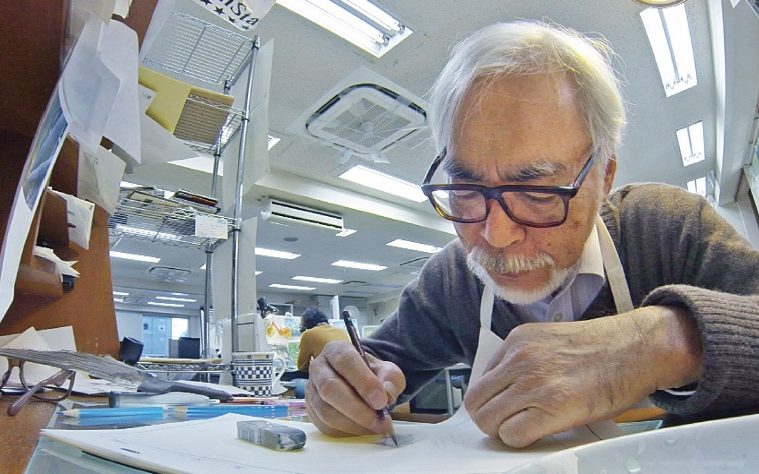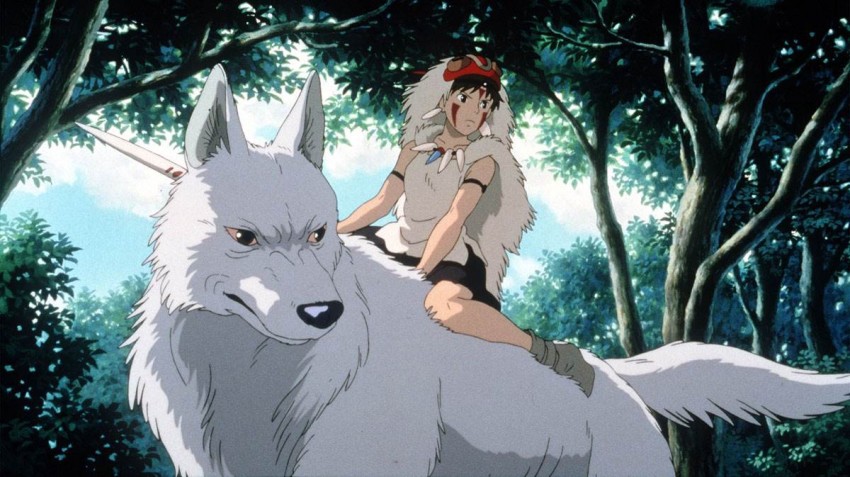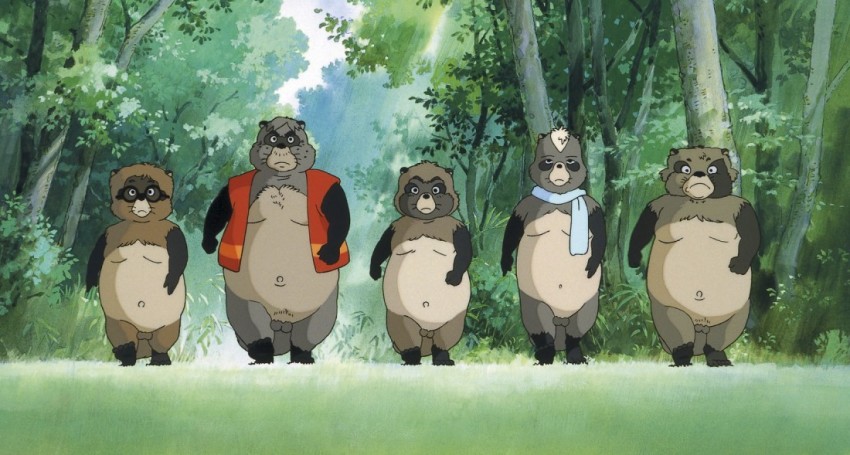Books: 15 Years at Studio Ghibli
May 25, 2020 · 0 comments
By Jonathan Clements.
 “Asked to be the voice of an angry 900-pound, twelve-foot-tall wolf god, Gillian Anderson did pretty well and handled the recording session with considerable grace.”
“Asked to be the voice of an angry 900-pound, twelve-foot-tall wolf god, Gillian Anderson did pretty well and handled the recording session with considerable grace.”
It’s all in a day’s work for Steve Alpert, the American executive hired to sell Studio Ghibli to the world. Originally part-released as a long-gone online diary, then published in a Japanese edition, Sharing a House with the Never-Ending Man: 15 Years at Studio Ghibli is his account of the wheeling and dealing behind the scenes at Japan’s most famous anime studio during those vital, game-changing years when it went global. It is an utterly priceless insider account, loaded with shouting matches, dastardly deals, moments of searing creative wisdom and fist-gnawing awkwardness. Ghibli, and anime, will never look the same again.
 Alpert won’t remember, but I dealt with him a couple of times myself when I was the editor of Manga Max magazine. He was unfailingly helpful and consummately professional, and not a bit like the gob-smacked, tongue-tied noob he describes here, trying not to stare down the cleavage of the silver-mini-skirted celeb sent to interview him for a late-night talk show. Nor was he anything like the angry, affronted press liaison who can be found here delivering a four-storey slap with a view of the park to an arrogant journalist from the New York Times, who demands a next-day interview with “Haiyo Miyazawa” who made that film about the boy riding the giant tiger, or something.
Alpert won’t remember, but I dealt with him a couple of times myself when I was the editor of Manga Max magazine. He was unfailingly helpful and consummately professional, and not a bit like the gob-smacked, tongue-tied noob he describes here, trying not to stare down the cleavage of the silver-mini-skirted celeb sent to interview him for a late-night talk show. Nor was he anything like the angry, affronted press liaison who can be found here delivering a four-storey slap with a view of the park to an arrogant journalist from the New York Times, who demands a next-day interview with “Haiyo Miyazawa” who made that film about the boy riding the giant tiger, or something.
Despite speaking Japanese and having worked in Japan for many years, Alpert is thrust into a world with an argot all of its own. He listens in bafflement as animators try to work out the best colour for a forest deity, conducting their argument almost entirely in pigment numbers as if ordering in a 1970s Chinese restaurant. Like Inuit discussing snow, the Ghibli animators have multiple words for rain, depending on if they want a dara dara effect or a peko peko. Swiftly, he gains an appreciation for the level of subliminal detail that Miyazaki invests in his films – calling the reader’s attention to the amount of effort that goes into creating a split-second shot of a crumbling roof tile.
Alpert has some golden advice for the pet gaijin in any company: “Don’t release your translation until you find out what it’s going to be used for.” He learns this the hard way when he’s asked to turn something into English, and only later discovers that the rough translation he dashed off has been sent straight to the printers. In discussing his travails as Ghibli’s go-to guy for translations, he reveals that it’s him who is at least partly responsible for Mononoke Hime going out with only half its title translated, leaving the word mononoke for “someone cleverer” to handle, only to discover that nobody had bothered.
I contest his (and Miyazaki’s) claim that mononoke is untranslatable – back when it was announced, we had no trouble at Manga Mania magazine coming up with a bunch of possibilities. If you don’t want to trawl through the back issues, I’m happy to tell you what they were for a vast fee, but regardless, Alpert’s frustrations demonstrate all too well the invisible pressures at work. Fans, and critics, have their whole lives to pick at creative decisions – the people who make them all too often have to make a call in seconds, and get to spend the rest of their lives reading about their mistakes on the Internet. “And yes,” writes Alpert. “It does hurt.”
He demonstrates with a six-syllable phrase from Princess Mononoke which, if properly unpacked in English, takes up to three times as long to say. And in a moment of surreal intercultural misunderstanding, he recalls the message he got from Disney about a plot point in Spirited Away, when someone steals a character’s seal, confusing a stamp with a semi-aquatic marine mammal.
On Laputa: Castle in the Sky, Alpert recounts the hassles over translating character names that, to him, seemed clearly to be Japanese stabs at the French pronunciation for Charles and Henri. “Disney’s translator,” writes Alpert with admirable sarcasm, “who was a third-generation Japanese-American and had never lived in Japan, and who also didn’t believe in asking questions, had decided the names were probably Chinese.”
His answer to this, as befits someone from a management background, is to create a five-person committee in which nobody can actually do the whole part of the job. However, he writes: “Hayao Miyazaki can say something in Japanese, and five people hearing him say it will have five completely different ideas about what it was that he meant. And none of them will be wrong.”
The amount of rewrites required, particularly for a fluent dub, often wrecks a translation so much that it can’t be pushed any further. Many anime fans are familiar with this problem from their experience of “dubtitling”, in which a subtitle script turns out not to translate the Japanese original, but what is said in the English dub. Alpert has to deal with this problem at an industrial level, particularly with those smaller language territories that will be translating not out of Japanese, but at one step removed, using the English script. Rather than deal with any more semantic drift, he organises “direct translations”, walking the process back a step so that Norwegian subtitlers can go through it all again, but with a closer appreciation of what the original may have meant.
 The book’s unexpectedly clunky title trades, inevitably, on Alpert’s time with Hayao Miyazaki, and there are plenty of eye-popping anecdotes here, not the least Miyazaki’s occasional suggestion that the entire staff be laid off after each film in order to keep them keen – nobody ever works out if he is joking. We get to see Miyazaki’s staff trying to lure him away on press junkets by promising the swamps of Estonia and the architecture of Vienna, and a gruff Miyazaki trolling foreign journalists, giving half a dozen different answers to the same trite question.
The book’s unexpectedly clunky title trades, inevitably, on Alpert’s time with Hayao Miyazaki, and there are plenty of eye-popping anecdotes here, not the least Miyazaki’s occasional suggestion that the entire staff be laid off after each film in order to keep them keen – nobody ever works out if he is joking. We get to see Miyazaki’s staff trying to lure him away on press junkets by promising the swamps of Estonia and the architecture of Vienna, and a gruff Miyazaki trolling foreign journalists, giving half a dozen different answers to the same trite question.
As any long-term Ghibli-watcher will know, the producer Toshio Suzuki has just as much of a role to play in the studio’s success. And Alpert is particularly good on Suzuki’s machinations behind the scenes, as he micro-manages the optics on Princess Mononoke, deliberately booking too few cinemas to make sure there were visibly long queues outside. And of course, the book includes that moment that Harvey Weinstein muses that Mononoke might benefit from a little trimming, and Suzuki presents him with a sword and the very clear message: “NO CUTS.”
Generations of anime historians yet unborn will snicker at Alpert’s account of the contractual negotiations between Ghibli-owners Tokuma Shoten and Buena Vista-owners Disney, in which Yasuyoshi Tokuma turns up after discussions are supposedly over, and announces that he wants to throw out the whole agreement and hammer it out, man-to-man with Michael O. Johnson, the executive who has come to Japan expecting to sign a done deal. Neither Tokuma nor Disney come out well in Alpert’s account – the Americans are presented as rude idiots, the Japanese as arrogant tossers, obscured by interpreters who literally lie about what is being said to stop things erupting into a fist-fight. Japanese minions pretend to give Tokuma everything he wants, but walk it all back in the small print of their contract, which they know Tokuma will never read.
Everything appears to have worked out, except Tokuma then breaks his own non-disclosure clause, and brags to the media about the size of the deal. This serves to attract the attention of the Japanese tax office, which refuses to believe that a company director could be working under the impression that his earnings are twice the size of what they actually are.
 You would hope that was the end of it all, but it’s only then, it seems, that people at Disney actually watch the package of films they have bought, and start to complain that there are guns in it, and raccoons with magic ball-sacks, and naked children in a bath with their dad. Alpert confirms, as I have long suspected, that the distribution contract with Disney included the right not to release Ghibli films at all, effectively nobbling Disney’s biggest competitor. Mr Tokuma, it turns out, was the studio’s unexpected saviour, since one of the results of his Trump-ish tantrums was that Ghibli retained digital rights. As DVD became a viable form of home video, Ghibli was able to use it to leverage back the rights in the films that some at Disney were hoping to mothball.
You would hope that was the end of it all, but it’s only then, it seems, that people at Disney actually watch the package of films they have bought, and start to complain that there are guns in it, and raccoons with magic ball-sacks, and naked children in a bath with their dad. Alpert confirms, as I have long suspected, that the distribution contract with Disney included the right not to release Ghibli films at all, effectively nobbling Disney’s biggest competitor. Mr Tokuma, it turns out, was the studio’s unexpected saviour, since one of the results of his Trump-ish tantrums was that Ghibli retained digital rights. As DVD became a viable form of home video, Ghibli was able to use it to leverage back the rights in the films that some at Disney were hoping to mothball.
As with the Japanese original, much of the book is centred on the production and release of Princess Mononoke. That was, of course, twenty years ago, so a lot has changed since, although I bet there are still film festivals out there that will put an inexperienced, first-time interpreter on the stage with a major director and hope she can wing it – a story that unfolds here like a slow-motion car-crash. Anime films no longer have to be checked onto planes as stacks of canisters the size of a filing cabinet, but this is all to the good, as Alpert records issues that remain crucial to understanding the history of film. He reports on piracy crackdowns in China, and the fights over Neil Gaiman’s script, which I won’t bother to go over here, as they are covered in detail in Motoko Tamamuro’s review of the Japanese version of this book.
Alpert has a gift for the minutiae of media life, whether it’s the food on the table at the meeting or the confusion of giving an awards speech when blinded by Klieg lights. He reports on the strange rituals of first-class travellers on Japan Air Lines, the egalitarian fawning of German press photographers who can’t afford to discover they missed out on someone who turned out to be famous, and that embarrassing moment when he accidentally grabbed Mira Nair’s boob. When Miyazaki refuses to go to Berlin if he only might win an award, Alpert is left to fly the company flag at the Golden Bears, despite not having the right shoes. He also reveals that Miyazaki doesn’t own his Oscar – like other modern winners, he only leases it from the Academy, to stop people from flogging off their awards for money.
 While it is indeed churlish to offer any complaints about such an entertaining, game-changing, explosive book, I will observe for the record that there aren’t really fifteen years manifest here. The book ends, more or less, with the 2000 funeral of Yasuyoshi Tokuma, although preceding chapters deal with the later release and success of Spirited Away. Chronology wavers a little, but that barely covers Alpert’s first five years at Ghibli, a studio that he did not leave for almost another decade. There is no discussion of Ghibli’s years in the doldrums after Miyazaki’s (second) attempted retirement, what must have been major spats over the company’s legacy direction, the Ghibli museum, or Miyazaki’s return to animation with The Wind Rises. Possibly, there are legal reasons – Alpert has left Ghibli now, and is presumably in witness protection somewhere after revealing that anime studio overtime directives are technically in breach of Japanese labour laws. Some of his stories gently obscure the identities of people who might take umbrage, but others are open about the ghastly behaviour of named individuals. I presume that more recent happenings might require a grace period to elapse before he can say where the bodies are buried.
While it is indeed churlish to offer any complaints about such an entertaining, game-changing, explosive book, I will observe for the record that there aren’t really fifteen years manifest here. The book ends, more or less, with the 2000 funeral of Yasuyoshi Tokuma, although preceding chapters deal with the later release and success of Spirited Away. Chronology wavers a little, but that barely covers Alpert’s first five years at Ghibli, a studio that he did not leave for almost another decade. There is no discussion of Ghibli’s years in the doldrums after Miyazaki’s (second) attempted retirement, what must have been major spats over the company’s legacy direction, the Ghibli museum, or Miyazaki’s return to animation with The Wind Rises. Possibly, there are legal reasons – Alpert has left Ghibli now, and is presumably in witness protection somewhere after revealing that anime studio overtime directives are technically in breach of Japanese labour laws. Some of his stories gently obscure the identities of people who might take umbrage, but others are open about the ghastly behaviour of named individuals. I presume that more recent happenings might require a grace period to elapse before he can say where the bodies are buried.
Maybe the years from Princess Mononoke to Spirited Away were Alpert’s heyday, and after that he was confined to dull box-ticking and accountancy. But I find that hard to believe – far more likely that he has another book in him, awaiting statues of limitations on all sorts of crimes against anime. I eagerly await a sequel that takes his career up to whatever it was that saw him leave the company around 2011, along with how the company saw him off. Was there no parting handshake and a slap on the back, no Totoro carriage-clock and an invitation to the office Christmas party? Alpert just stops talking, as if he has been suddenly called away to answer his second or third phone, leaving the reader sitting in a notional conference room, wondering if this remarkable meeting is truly over.
In the midst of all of this, surrounded by toadies and flunkies, duelling cockswans and shouty executives, Hayao Miyazaki sends back his drink at a restaurant, telling the waiter that it is not the forty-year-old port that he ordered. The waiter insists that it is, but Miyazaki sticks to his guns, until a sheepish manager admits that they had, indeed, tried to fob him off with a cheaper variety. He remains the only one who is true of heart, in a Sea of Corruption.
Jonathan Clements is the author of Anime: A History. Sharing a House with the Never-Ending Man: 15 Years at Studio Ghibli is published in June by Stone Bridge Press.
Leave a Reply